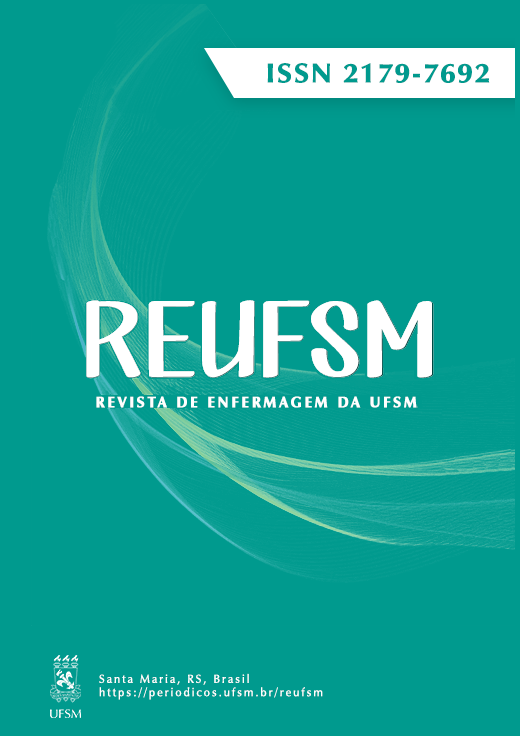Teaching strategies for nursing care in stroke: an integrative review
DOI:
https://doi.org/10.5902/2179769283858Keywords:
Students, Nursing, Teaching, Learning, Stroke, Education, NursingAbstract
Objective: to identify the pedagogical strategies used in teaching nursing care to stroke victims. Method: integrative review, carried out between September 2022 and March 2023 in seven sources of information. The Rayyan application was used for the selection and thematic analysis of the 485 manuscripts, of which seven constituted the sample. Results: Clinical simulation, interactive computer-assisted instruction, instructor-led videotape, vignettes, multimedia e-learning tool and workshop were identified as pedagogical strategies. Conclusion: Six strategies were identified, with clinical simulation standing out as the method most often mentioned in studies as the only one capable of developing cognitive, psychomotor, and affective skills in nursing students.
Downloads
References
Moraes MA, Mussi FC, Muniz LS, Sampaio ES, Leitão TS, Santos CAST, et al. Clinical characterization, disability, and mortality in people with strokes during 90 days. Rev Bras Enferm. 2022; 75(2):e20201383. DOI: https://doi.org/10.1590/0034-7167-2020-1383.
Araújo JP, Darcis JVV, Tomas ACV, Mello WA. Mortality Trend Due to Cerebrovascular Accident in the City of Maringá, Paraná between the Years of 2005 to 2015. Int J Cardiovasc Sci. 2018; 31(1):56–62. DOI: https://doi.org/10.5935/2359-4802.20170097.
Santos LB, Waters, C. Perfil epidemiológico dos pacientes acometidos por acidente vascular cerebral: revisão integrativa. Braz J of Develop. 2020; 6(1):2749–2775. DOI: https://doi.org/10.34117/bjdv6n1-198.
Oliveira GG, Waters C. Perfil epidemiológico dos pacientes com acidente vascular cerebral isquêmico. Arq Med Hosp Fac Cienc Med Santa Casa São Paulo. 2021; 66(1):e019. DOI: https://doi.org/10.26432/1809-3019.2021.66.019.
Silva DN, Melo MFX, Ériko MMM, Borges AKP. Cuidados de enfermagem à vítima de acidente vascular cerebral (AVC): Revisão integrativa. REAS. 2019; (36):e2156. DOI: https://doi.org/10.25248/reas.e2136.2019.
Oliveira JHM, Cabanha MWC, Pereira TO, Lescano FA, Lopes EFB, Silva LSA, et al. Assistência de enfermagem ao paciente vítima de acidente vascular cerebral. PECIBES [Internet]. 2020 [acesso em Nov 20]; 5(2):44. Disponível em: https://periodicos.ufms.br/index.php/pecibes/article/view/10311.
Barbosa KK, Silva RAN, Barbosa DA, Abrao KR. Metodologias ativas na aprendizagem significativa de enfermagem. Rev Humanid Inov [Internet]. 2021 [acesso em Nov 28]; 8(44):100-109. Disponível em: https://revista.unitins.br/index.php/humanidadeseinovacao/article/view/4460.
Nascimento JSG, Pires FC, Nascimento KG, Regino DSG, Siqueira TV, Dalri MCB. Methodological quality of validation of studies on simulated scenarios in nursing. Rev Rene. 2021; 22:e62459. DOI: https://doi.org/10.15253/2175-6783.20212262459.
Mendes KDS, Silveira RCCP, Galvão CM. Uso de gerenciador de referências bibliográficas na seleção dos estudos primários em revisão integrativa. Texto Contexto Enferm. 2019;28(20). DOI: https://doi.org/10.1590/1980-265X-TCE-2017-0204.
Mendes KDS, Silveira RCCP, Galvão CM. Revisão integrativa: método de pesquisa para a incorporação de evidências na saúde e na enfermagem. Texto contexto enferm. 2008; 17(4):758–64. DOI: https://doi.org/10.1590/S0104-07072008000400018.
Sousa LMM, Marques JM, Firmino CF, Frade F, Valentim OS, Antunes AV. Modelos de formulação da questão de investigação na prática baseada na evidência. Rev Investig Enferm [Internet]. 2018 [acesso em 2023 Jan 29];31-39. Disponível em: https://www.researchgate.net/publication/325699143_MODELOS_DE_FORMULACAO_DA_QUESTAO_DE_INVESTIGACAO_NA_PRATICA_BASEADA_NA_EVIDENCIA.
Ursi ES, Galvão CM. Perioperative prevention of skin injury: an integrative literature review. Rev Latino-Am Enferm. 2006;14(1):124-31. DOI: https://doi.org/10.1590/S0104-11692006000100017.
Melnyk BM, Fineout-Overholt E, Stillwell SB, Williamson KM. Evidence-based practice: step by step: the seven steps of evidence-based practice. Am J Nurs. 2010;110(1):51- 3. DOI: https://doi.org/10.1097/01.naj.0000366056.06605.d2.
Minayo MCS. O Desafio do Conhecimento: Pesquisa Qualitativa em Saúde. 10. ed. São Paulo: HUCITEC, 2007.
Emanuel V, Cross V. Using vignettes to teach stroke care. Nurs Times [Internet]. 2012 [cited 2023 Jan 29]; 108(9):20-22. Available from: https://pubmed.ncbi.nlm.nih.gov/22479769/.
Birns J, Woodward P, Brenton H, Bello F. Development of a Novel Multimedia E-Learning Tool for Teaching the Symptoms and Signs of Stroke. Creative Education. 2018; 09(08):1196-1211. DOI: https://doi.org/10.4236/ce.2018.98089.
Chiu S-C, Cheng K-Y, Sun T-K, Chang K-C, Tan T-Y, Lin T-K, et al. The effectiveness of interactive computer assisted instruction compared to videotaped instruction for teaching nurses to assess neurological function of stroke patients: a randomized controlled trial. Int j nurs stud. 2009; 46(12):1548-1556. DOI: http://dx.doi.org/10.1016/j.ijnurstu.2009.05.008.
Dehghan Z, Alimohammadi N, Mohamadirizi S. Comparison of two new educational techniques on knowledge of nurses about cerebrovascular accident nursing care in emergency department. J Educ Health Promot [Internet]. 2022 [cited 2023 Jan 29]; 11:60. Available from: https://pubmed.ncbi.nlm.nih.gov/35372591/.
Casolla B, Leciñana MA, Neves R, Pfeilschifter W, Svobodova V, Jung S, et al. Simulation training programs for acute stroke care: Objectives and standards of methodology. Eur Stroke J. 2020; 5(4):328-335. DOI: https://doi.org/10.1177/2396987320971105.
Karpa K, Pinto C, Possanza A, Santos J, Snyder M, Salvadia A, et al. Stroke Simulation Activity: a standardized patient case for interprofessional student learning. MedEdPortal. 2018; 14: 10698. DOI: https://doi.org/10.15766/mep_2374-8265.10698.
Roots A, Thomas L, Jaye P, Birns J. Simulation training for hyperacute stroke unit nurses. Br j nurs. 2011; 20(21):1352-1356. DOI: http://dx.doi.org/10.12968/bjon.2011.20.21.1352.
Schmidt MH, Selau CM, Soares PS, Franchi EF, Piber VD, Quatrin LB. Acidente vascular cerebral e diferentes limitações: uma análise interdisciplinar. Arq. ciências saúde UNIPAR. 2019; 23(2):139-144. DOI: https://doi.org/10.25110/arqsaude.v23i2.2019.6404.
Dutra HS, Reis VN. Experimental and quasi-experimental study designs: definitions and challenges in nursing research. Rev enferm UFPE on-line [Internet]. 2016 [cited 2023 Feb 16]; 10(6):2230-41. Available from: https://periodicos.ufpe.br/revistas/revistaenfermagem/article/viewFile/11238/12840.
Nascimento JSG, Nascimento KG, Oliveira JLG, Alves MG, Silva AR, Dalri MCB. Clinical simulation for nursing competence development in cardiopulmonary resuscitation: systematic review. Rev latinoam enferm. 2020; 28: e3391. DOI: http://dx.doi.org/10.1590/1518-8345.4094.3391.
Howerton WBJR, Enrique PR, Ludlow JB, Tyndall DA. Interactive Computer-Assisted Instruction vs. Lecture Format in Dental Education. J dent hyg [Internet]. 2004 [cited 2023 Feb 16]; 78(4):10. Available from: https://pubmed.ncbi.nlm.nih.gov/16197750/.
Martin P, Klotz L, Alfred D. Longitudinal evaluation of a live interactive video baccalaureate nursing program. Nurse educ [Internet]. 2007 [cited 2023 Feb 19]; 32(1):43-7. Available from: https://journals.lww.com/nurseeducatoronline/Abstract/2007/01000/Longitudinal_Evaluation_of_a_Live_Interactive.12.aspx.
Schmidt B, Stewart S. Implementing the virtual reality learning environment: Second Life. Nurse educ. 2009; 34(4):152-5. DOI: http://dx.doi.org/10.1097/NNE.0b013e3181aabbe8.
Marques HR, Campos AC, Andrade DM, Zambalde AL. Inovação no ensino: uma revisão sistemática das metodologias ativas de ensino-aprendizagem. Avaliação. 2021; 26(3). DOI: https://doi.org/10.1590/S1414-40772021000300005.
Published
Versions
- 2023-12-15 (2)
- 2023-12-11 (1)
How to Cite
Issue
Section
License
Copyright (c) 2023 Revista de Enfermagem da UFSM

This work is licensed under a Creative Commons Attribution-NonCommercial-ShareAlike 4.0 International License.
This work is licensed under a Creative Commons Attribution-NonCommercial-ShareAlike 4.0 International License.








